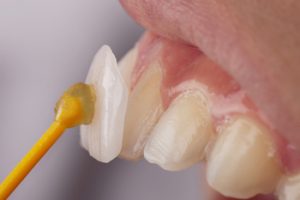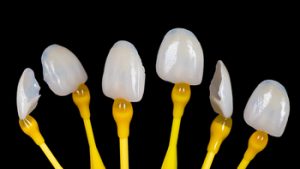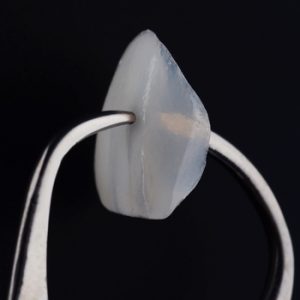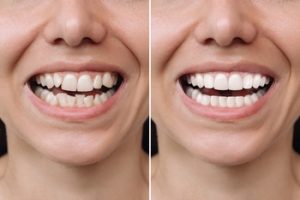Introduction
Dental veneers have emerged as a cornerstone in cosmetic dentistry, transforming smiles with their ability to correct dental imperfections. These thin shells, typically made of porcelain or composite resin, are meticulously crafted to cover the front surface of teeth, enhancing the appearance of your smile. Traditional porcelain veneers are renowned for their durability and stain-resistant qualities, making them a highly sought-after solution for those seeking a brighter, straighter smile. They effectively address issues such as chipped teeth, stained teeth, misshapen teeth, and even minor misalignments, offering a transformative cosmetic dental treatment.
While dental veneers, particularly porcelain veneers, are often considered the epitome of cosmetic dental procedures, exploring alternative treatments is essential. This blog delves into various options available in cosmetic dentistry, from teeth whitening treatments and dental bonding to dental crowns and composite resin veneers. Each alternative to veneers presents unique benefits, catering to different dental issues and preferences. However, throughout this exploration, we will continually highlight why veneers, with their ability to preserve the natural tooth structure while offering a transformative effect, often emerge as the superior choice for those seeking to enhance the natural beauty of their smile.
Making informed decisions about dental care is crucial. Whether dealing with discoloured, crooked, chipped, or even severely decayed teeth, understanding the full spectrum of cosmetic treatments – from tooth whitening to dental implants – empowers individuals to choose the best course of action for their dental health. This blog aims to demystify each cosmetic procedure, including affordable alternatives to traditional veneers, such as composite resin material options or in-office whitening, and compare them against dental veneers’ effectiveness and aesthetic advantages. By exploring each option, from the minimal enamel removal required for composite veneers to the comprehensive coverage dental crowns provide, we aim to guide you through the myriad of choices, assisting in finding the most suitable cosmetic dental treatment for a natural, healthy, and radiant smile.
Understanding Dental Veneers

A. Definition and Description of Dental Veneers
Dental veneers, often referred to as porcelain veneers or composite resin veneers, are thin shells designed to cover the front surface of teeth, enhancing the appearance of your smile. Made from porcelain or composite resin, these veneers are custom-made to fit the natural structure of your existing teeth. Veneers are a popular cosmetic dental procedure that improves dental aesthetics by addressing issues like stained teeth, chipped teeth, misshapen teeth, or even minor alignment problems like crooked or misaligned teeth.
B. Benefits of Choosing Veneers
Veneers offer numerous benefits as a cosmetic dental treatment. Firstly, they provide a natural tooth appearance, seamlessly blending with your existing teeth. Porcelain veneers are particularly praised for their stain-resistant qualities and ability to mimic the light-reflecting properties of natural tooth enamel. This makes them ideal for those seeking a brighter, whiter smile without requiring continual teeth whitening treatments. Additionally, veneers require minimal enamel removal compared to other dental treatments like dental crowns, thus preserving more of your natural tooth structure.
C. Potential Drawbacks and Considerations
While dental veneers are a highly effective cosmetic procedure, there are potential drawbacks and considerations to be aware of. The process of placing veneers involves the permanent alteration of your natural teeth, which can lead to increased tooth sensitivity. It’s also crucial to note that, unlike treatments such as tooth bonding or dental bonding procedures, veneers are not reversible. Furthermore, while veneers are durable, they may not suit individuals with severe dental issues like decayed teeth or gum disease. More comprehensive dental treatments, such as dental crowns or implants, may be recommended in such cases.
D. Ideal Candidates for Veneers
The ideal candidates for dental veneers are individuals looking to improve their teeth’ cosmetic appearance while maintaining their natural teeth’ general health. Veneers are excellent for correcting dental imperfections, such as minor chips, stained teeth, or slightly crooked teeth. However, candidates should have a healthy dental foundation, meaning no active tooth decay or gum disease. It’s also essential for candidates to have realistic expectations of the outcome and a commitment to maintaining good oral hygiene post-procedure.
Alternative Options to Veneers

A. Dental Bonding
- Description and Procedure: Dental bonding is a cosmetic dental treatment that involves the application of a tooth-coloured composite resin material to repair chipped, fractured, discoloured, or decayed teeth. This procedure is typically less invasive than veneers, as it requires minimal enamel removal and can often be completed in a single visit to an experienced dentist.
- Pros and Cons Compared to Veneers: The major advantage of dental bonding over traditional porcelain veneers is its affordability and minimally invasive nature. Bonding is a more affordable alternative, ideal for minor cosmetic changes and treating damaged teeth needing quick repairs. However, unlike the durable porcelain used in veneers, the composite resin in dental bonding is less stain-resistant and may only last for a short time.
- Suitable Cases for Dental Bonding: Dental bonding is best suited for individuals with minor dental imperfections such as small chips, cracks, or slight discolourations. It’s also viable for those seeking a less expensive and quicker cosmetic dental procedure.
B. Teeth Whitening
- Various Teeth Whitening Methods: Teeth whitening treatments range from in-office whitening procedures offering immediate results to at-home whitening kits and toothpaste. These methods lighten teeth and remove surface stains, enhancing the overall brightness of one’s smile.
- Advantages and Limitations: The main advantage of teeth whitening treatments is their ability to significantly improve the appearance of stained teeth without the need for invasive procedures. However, they are limited in their ability to address structural dental imperfections and may not be suitable for those with tooth sensitivity or severely decayed teeth.
- Effectiveness in Comparison to Veneers: While effective for achieving a whiter smile, teeth whitening treatments are not a substitute for veneers for correcting misshapen, crooked, or severely stained teeth. Veneers, on the other hand, can address these issues while also offering a more permanent solution.
C. Orthodontics (Braces and Aligners)
- Types of Orthodontic Treatments: Orthodontic treatments include traditional metal braces and clear aligners. These treatments correct misaligned teeth and bite issues, contributing to a straighter smile and improved dental health.
- Long-Term Benefits and Challenges: Orthodontic treatments offer long-term benefits such as improved bite function and easier oral hygiene. However, they require a longer treatment period and consistent care.
- Comparing Orthodontics to Veneers for Smile Correction: Unlike veneers, which are primarily cosmetic, orthodontics addresses the functional alignment of teeth. While veneers can quickly improve the appearance of your teeth, orthodontic treatments offer a more holistic solution to misaligned teeth without altering the tooth’s surface.
D. Dental Crowns
- Overview of Dental Crowns: Dental crowns are restorative caps placed over a tooth to restore its shape, size, strength, and appearance. Crowns are used in severely decayed teeth, damaged teeth, or after root canal therapy.
- Comparison with Veneers in Terms of Durability and Aesthetics: While dental crowns and veneers improve the appearance of teeth, crowns encase the entire tooth, offering greater structural support. Crowns are typically more durable than veneers and are preferable in cases of significant tooth decay or when the tooth’s structure is compromised.
- Situations Where Crowns are Preferable: Dental crowns are preferred for teeth that have undergone significant structural damage, extensive decay, or following a root canal. They provide a comprehensive solution that veneers cannot offer in severely compromised dental health cases.
Why Veneers Might Still Be the Best Option
A. Long-term Aesthetics and Durability
Porcelain veneers, known for their exceptional long-term aesthetics, stand out as a superior option in cosmetic dentistry. Unlike alternative treatments such as tooth whitening or dental bonding, which might require frequent touch-ups, traditional porcelain veneers offer a durable solution for a brighter, straighter smile. Their resistance to stains and ability to withstand daily wear make them a preferred choice for those looking to permanently address a range of dental imperfections. Composite veneers, while an affordable alternative, may not match their porcelain counterparts’ longevity and stain-resistant qualities.
B. Minimal Maintenance Requirements
One of the key advantages of choosing dental veneers over other cosmetic dental treatments is their minimal maintenance requirements. Porcelain veneers, in particular, mimic the natural tooth structure, allowing for routine dental care without additional hassle. This ease of maintenance contrasts with options like dental crowns or dental bonding procedures, which might necessitate more specific care or frequent visits to the dentist for upkeep.
C. Versatility in Addressing Multiple Dental Issues
Dental veneers, especially porcelain veneers, are versatile in correcting various dental issues. From chipped and misshapen teeth to severe discolouration and minor misalignments, veneers can comprehensively address these concerns. This versatility is often unmatched by alternative treatments such as teeth whitening, which only lightens teeth, or dental crowns, which are generally used for more severely decayed or damaged teeth. The ability of veneers to fix a wide range of aesthetic concerns in a single procedure makes them a more encompassing solution than other cosmetic procedures.
D. Customisation and Natural Appearance
The customisation aspect of dental veneers is a significant factor in their favour. Whether opting for porcelain or composite resin veneers, they are tailor-made to match the natural colour and shape of your existing teeth, ensuring a natural smile. This individualised approach results in a more natural and aesthetically pleasing outcome than general whitening treatments or dental bonding, which might blend differently with natural tooth enamel. Additionally, applying veneers involves minimal enamel removal, preserving most of the natural tooth structure, unlike crowns or other dental treatments requiring more extensive preparation.
Considerations Before Choosing an Alternative

A. Assessing Dental Health and Needs
Before opting for an alternative to veneers, it’s crucial to assess your dental health thoroughly. This involves evaluating the condition of your natural teeth, including tooth decay, tooth enamel quality, and any existing dental issues like gum disease or severely decayed teeth. The structural integrity of your natural tooth structure, including any misshapen, chipped, or crooked teeth, will significantly influence the treatment choice. Cosmetic treatments, whether it’s dental bonding, dental crowns, or teeth whitening, should align with your teeth’ specific needs and conditions.
B. Understanding the Financial Implications
Each cosmetic dental procedure, from porcelain veneers to composite resin veneers or dental bonding, carries its financial implications. While treatments like tooth whitening or tooth bonding may be more affordable alternatives, others, like traditional porcelain veneers or dental crowns, may entail a higher cost. Understanding these financial aspects is key to making an informed decision. It’s important to consider both the procedure’s initial cost and ongoing maintenance costs.
C. Considering Longevity and Maintenance of the Procedure
The longevity and maintenance required for different cosmetic dental treatments vary. For instance, dental veneers, made of porcelain or composite resin, usually offer a longer-lasting solution than dental bonding. On the other hand, treatments like teeth whitening require regular sessions to maintain a bright smile. Considering how much time and effort you’re willing to invest in maintaining your teeth post-treatment is vital. This includes regular dental care, the potential for tooth sensitivity, and the need for repeat procedures.
D. Consultation with a Dental Professional
Consulting with an experienced dentist is the most crucial step in the process. A dental professional can comprehensively assess your dental health, offer recommendations tailored to your specific dental issues, and explain the pros and cons of each procedure, from dental crowns to teeth whitening treatments. They can guide you through the nuances of each alternative treatment, including the impact on your natural tooth enamel, the effectiveness of different procedures in fixing dental imperfections, and the suitability of certain treatments for misaligned teeth or other cosmetic dental issues.
Considerations Before Choosing an Alternative

A. Assessing Dental Health and Needs
Before opting for an alternative to veneers, it’s crucial to assess your dental health thoroughly. This involves evaluating the condition of your natural teeth, including tooth decay, tooth enamel quality, and any existing dental issues like gum disease or severely decayed teeth. The structural integrity of your natural tooth structure, including any misshapen, chipped, or crooked teeth, will significantly influence the treatment choice. Cosmetic treatments, whether it’s dental bonding, dental crowns, or teeth whitening, should align with your teeth’ specific needs and conditions.
B. Understanding the Financial Implications
Each cosmetic dental procedure, from porcelain veneers to composite resin veneers or dental bonding, carries its financial implications. While treatments like tooth whitening or tooth bonding may be more affordable alternatives, others, like traditional porcelain veneers or dental crowns, may entail a higher cost. Understanding these financial aspects is key to making an informed decision. It’s important to consider both the procedure’s initial cost and ongoing maintenance costs.
C. Considering Longevity and Maintenance of the Procedure
The longevity and maintenance required for different cosmetic dental treatments vary. For instance, dental veneers, made of porcelain or composite resin, usually offer a longer-lasting solution than dental bonding. On the other hand, treatments like teeth whitening require regular sessions to maintain a bright smile. Considering how much time and effort you’re willing to invest in maintaining your teeth post-treatment is vital. This includes regular dental care, the potential for tooth sensitivity, and the need for repeat procedures.
D. Consultation with a Dental Professional
Consulting with an experienced dentist is the most crucial step in the process. A dental professional can comprehensively assess your dental health, offer recommendations tailored to your specific dental issues, and explain the pros and cons of each procedure, from dental crowns to teeth whitening treatments. They can guide you through the nuances of each alternative treatment, including the impact on your natural tooth enamel, the effectiveness of different procedures in fixing dental imperfections, and the suitability of certain treatments for misaligned teeth or other cosmetic dental issues.
Conclusion

Throughout this exploration of dental alternatives, we’ve delved into options ranging from dental bonding and teeth whitening treatments to dental crowns and orthodontic solutions. Each alternative caters to specific dental needs, whether correcting minor chips with tooth bonding, brightening stained teeth with whitening treatments, or addressing misshapen or severely decayed teeth with dental crowns. However, despite these varied options, porcelain veneers remain a top choice for those seeking a comprehensive solution for various cosmetic dental issues. They offer a balance between preserving natural tooth structure and enhancing the overall appearance of your teeth.
Choosing the right cosmetic dental treatment, whether it’s dental veneers, composite resin veneers, or other alternatives, is a significant decision that impacts your smile and overall dental health. We strongly encourage consulting with experienced dentists who can provide personalised advice based on your dental conditions, such as tooth decay, enamel removal needs, or dental imperfections. Professional guidance is essential in navigating the array of treatments, from traditional porcelain veneers to more affordable alternatives.
Achieving the best smile is a journey unique to each individual. It involves considering various factors, including your teeth’ natural structure and health, cosmetic desires, and lifestyle needs. While porcelain veneers and their alternatives, like dental bonding or teeth whitening, offer pathways to enhance your smile, the final choice should align with your personal goals, dental health, and aesthetic preferences. Remember, the goal is a brighter or straighter smile and a healthy, natural smile that boosts your confidence and well-being.
To explore your options further and receive expert advice tailored to your dental needs, we invite you to visit Beyond Infinity Dental. Our team of skilled dental professionals is committed to helping you achieve your dream smile with the utmost care and expertise. Contact us at (02) 8806 3799 to schedule your consultation and take the first step towards a brighter, healthier smile.
References:
https://www.ncbi.nlm.nih.gov/pmc/articles/PMC6076883/
www.dentalnews.com/2023/07/14/understanding-porcelain-veneers-a-comprehensive-guide.
https://www.healthline.com/health/dental-veneers
https://www.webmd.com/oral-health/veneers
https://www.researchgate.net/publication/367540050_Porcelain_Veneers_in_Vital_vs_Non-Vital_Teeth_A_Retrospective_Clinical_Evaluation









